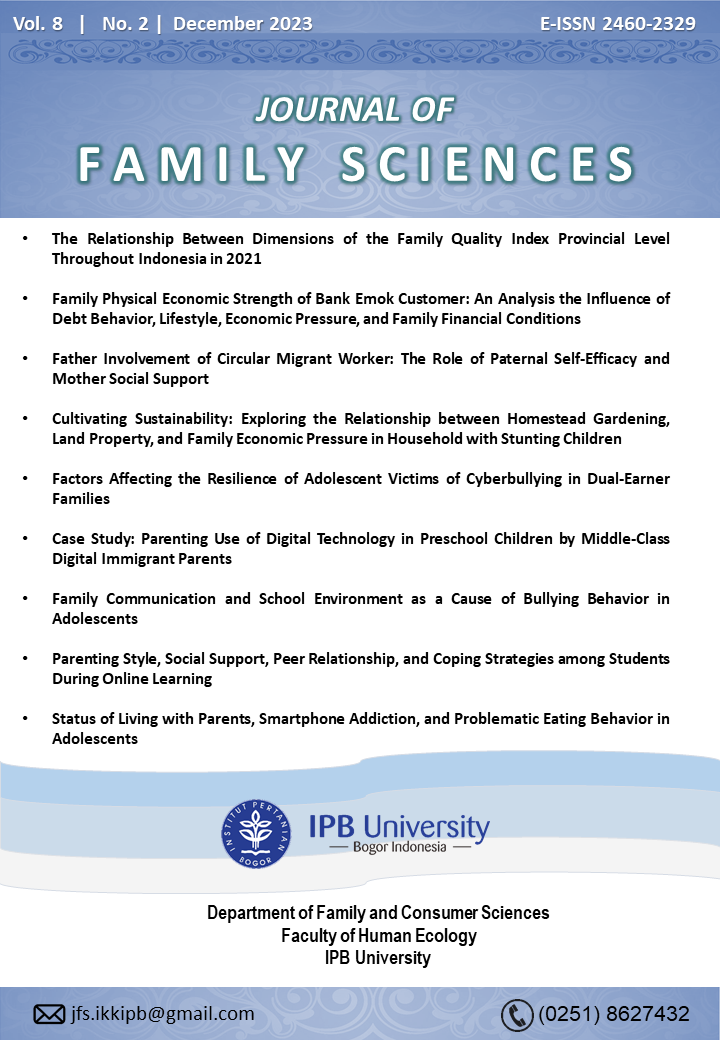Cultivating Sustainability: Exploring the Relationship between Homestead Gardening, Land Property, and Family Economic Pressure in Household with Stunting Children
Abstract
The impacts of climate change exacerbate the problems of food insecurity and malnutrition, especially child stunting. This study aims to characterize households with stunted children and explore the relationship between yard agroecosystem management strategies, yard ownership, and family economic stress. The study was conducted among 68 households with stunted children in Sumedang District, West Java, selected using purposive sampling. The results found that only 11.7 percent had a dedicated yard with a low level of cultivation and utilization of agrobiodiversity. Correlation analysis showed that the husband's education level was significantly positively associated with yard ownership and utilization. The husband's age and family size were significantly positively related to objective economic pressure. The wife's education and per capita income were significantly negatively related to objective economic pressure. Meanwhile, subjective economic pressure was significantly negatively related to per capita income and significantly positively related to objective economic pressure.
Downloads
References
Ainamani, H. E., Bamwerinde, W. M., Rukundo, G. Z., Tumwesigire, S., Kalibwani, R. M., Bikaitwaho, E. M., & Tsai, A. C. (2021). Participation in gardening activity and its association with improved mental health among family caregivers of people with dementia in rural Uganda. Preventive Medicine Reports, 23(May), 101412. https://doi.org/10.1016/j.pmedr.2021.101412
Akrofi, S., Struik, P. C., & Price, L. L. (2008). Interactive effects of HIV/AIDS and household headship determine home garden diversity in the Eastern Region of Ghana. NJAS - Wageningen Journal of Life Sciences, 56(3), 201–217. https://doi.org/10.1016/S1573-5214(08)80008-5
Al-Dala’een, J. A. (2018). The Economics of Plant Production of Household Garden. Journal of Agricultural Science, 10(3), 298–306. https://doi.org/10.5539/jas.v10n3p298
Arida, A., Sofyan, & Fadhiela, K. (2015). Analisis ketahanan pangan rumah tangga berdasarkan proporsi pengeluaran pangan dan konsumsi energi: Studi kasus pada rumah tangga petani peserta program desa mandiri pangan di Kecamatan Indrapuri Kabupaten Aceh Besar. Jurnal Agrisep Unsyiah, 16(1), 20–34.
Asfaw, A., & Zewudie, S. (2021). Soil macrofauna abundance, biomass and selected soil properties in the home garden and coffee-based agroforestry systems at Wondo Genet, Ethiopia. Environmental and Sustainability Indicators, 12, 100153. https://doi.org/10.1016/j.indic.2021.100153
Ashari, Saptana, & Purwantini, T. B. (2012). Potential use of backyard land for food security. Forum Penelitian Agro Ekonomi, 30(1), 13–30. https://doi.org/10.21082/fae.v30n1.2012.13-30
Ayuningtyas, C. E., & Jatmika, S. E. D. (2019). Pemanfaatan Lahan Pekarangan untuk Meningkatkan Gizi Keluarga. In Penerbit K-Media. K-Media.
[BPS] Badan Pusat Statistik. (2022). Profil kemiskinan di Indonesia Maret 2022. Retrieved from https://www.bps.go.id/pressrelease/2023/07/17/2016/profil-kemiskinan-di-indonesia-maret-2023.html
Caballero-Serrano, V., McLaren, B., Carrasco, J. C., Alday, J. G., Fiallos, L., Amigo, J., & Onaindia, M. (2019). Traditional ecological knowledge and medicinal plant diversity in Ecuadorian Amazon home gardens. Global Ecology and Conservation, 17, e00524. https://doi.org/10.1016/j.gecco.2019.e00524
Chaireni, R., Agustanto, D., Wahyu, R. A., & Nainggolan, P. (2020). Ketahanan pangan berkelanjutan. Jurnal Kependudukan dan Pembangunan Lingkungan, 2, 23–32. http://jkpl.ppj.unp.ac.id/index.php/JKPL/article/view/13/8
Chalmin-Pui, L. S., Griffiths, A., Roe, J., Heaton, T., & Cameron, R. (2021). Why garden? – Attitudes and the perceived health benefits of home gardening. Cities, 112(October), 103118. https://doi.org/10.1016/j.cities.2021.103118
Corrigan, M. P. (2011). Growing what you eat: Developing community gardens in Baltimore, Maryland. Applied Geography, 31(4), 1232–1241. https://doi.org/10.1016/j.apgeog.2011.01.017
Danso, F., & Appiah, M. A. (2023). Prevalence and associated factors influencing stunting and wasting among children of ages 1 to 5 years in Nkwanta South Municipality, Ghana. Nutrition, 110, 1–9. https://doi.org/10.1016/j.nut.2023.111996
De Lange, M., Wolbers, M. H. J., & Ultee, W. C. (2013). United in precarious employment? employment precarity of young couples in the Netherlands, 1992-2007. European Sociological Review, 29(3), 503–516. https://doi.org/10.1093/esr/jcr093
Depenbusch, L., Schreinemachers, P., Roothaert, R., Namazzi, S., Onyango, C., Bongole, S., & Mutebi, J. (2021). Impact of home garden interventions in East Africa: Results of three randomized controlled trials. Food Policy, 104, 102140. https://doi.org/10.1016/j.foodpol.2021.102140
Ding, X., Zhao, Z., Zheng, J., Yue, X., Jin, H., & Zhang, Y. (2022). Community gardens in China: Spatial distribution, patterns, perceived benefits and barriers. Sustainable Cities and Society, 84, 103991. https://doi.org/10.1016/j.scs.2022.103991
Diwanti, D. P. (2018). Pemanfaatan pertanian rumah tangga: Pekarangan rumah dengan teknik budidaya tanaman sayuran secara vertikultur. Martabe, 1(3), 101–107.
[FAO] Food and Agriculture Organization of the United Nations. (2010). The State of Food Insecurity in the World Addressing food insecurity in protracted crises. Retrieved from Rome: https://www.unep.org/news-and-stories/story/rethinking-food-system
Feriatin. (2017). The diversity of garden plants and their utilization for supporting food security the sub District of South Wakorumba. Jurnal Ilmu Pertanian Indonesia (JIPI), 22(2), 99–107. https://doi.org/10.18343/jipi.22.2.99
Firdaus, F, & Sunarti, E. (2009). Hubungan antara tekanan ekonomi dan mekanisme koping dengan kesejahteraan keluarga wanita pemetik teh. Jurnal Ilmu Keluarga dan Konsumen, 2(1),21–31. https://doi.org/10.24156/jikk.2009.2.1.21.
Galhena, D. H., Freed, R., & Maredia, K. M. (2013). Home gardens: A promising approach to enhance household food security and well-being. In Agriculture and Food Security, 2 (1), 1–13. BioMed Central Ltd. https://doi.org/10.1186/2048-7010-2-8
Guell, C., Brown, C. R., Iese, V., Navunicagi, O., Wairiu, M., & Unwin, N. (2021). “We used to get food from the garden.” Understanding changing practices of local food production and consumption in small island states. Social Science and Medicine, 284, 114214. https://doi.org/10.1016/j.socscimed.2021.114214
Hermanto. (2015). Indonesian food security in the ASEAN region. Forum Penelitian Agro Ekonomi, 33(1), 19–31. Retrieved from https://media.neliti.com/media/publications/62042-ID-ketahanan-pangan-indonesia-di-kawasan-as.pdf
Irfansyah, H., & Rahmawati, F. (2021). Ketahanan pangan rumah tangga petani selama pandemi Covid-19 (Studi pada Kelompok Tani Kenanga Mulya Desa Langon). Ecoplan, 4(2), 111–121. https://doi.org/10.20527/ecoplan.v4i2.381
Irwan, S. N. R., Rogomulyo, R., & Trisnowati, S. (2018). Utilization of “Pekarangan” through productive landscape development in Mangunan Village, Bantul District Yogyakarta. Jurnal Ilmu Pertanian Indonesia, 23(2), 148–157. https://doi.org/10.18343/jipi.23.2.148
Johnson-Welch, C., Alemu, B., Msaki, T., Sengendo, M., Kigutha, H., & Wolff, A. (2000). Improving household food security: Institutions, gender and integrated approaches. Davis CA, USA
Karlsson, O., Kim, R., Joe, W., & Subramanian, S. V. (2019). The relationship of household assets and amenities with child health outcomes: An exploratory cross-sectional study in India 2015–2016. SSM - Population Health , 10, 1–9. https://doi.org/10.1016/j.ssmph.2019.100513
[Kemendagri] Kementerian Dalam Negeri/Ministry of Internal Affairs. (2023). Monitoring pelaksanaan 8 aksi konvergensi intervensi penurunan stunting terintegrasi. Retrieved from https://aksi.bangda.kemendagri.go.id/emonev/DashPrev
Laily, F. M., & Sunarti, E. (2022). Objective economic pressures, livelihood strategies, and subjective-economic welfare of survivor’s families of Sunda Strait Tsunami in Banten. Journal of Family Sciences, 7(1), 29–42. https://doi.org/10.29244/jfs.v7i1.40960
Lee, H. (2022). Family economic hardship and children’s behavioral and socio-emotional outcomes in middle childhood: Direct and indirect pathways rights and content. Children and Youth Services Review, 138, 1–9. https://doi.org/10.1016/j.childyouth.2022.106527Get
Marques, P., Silva, A. S., Quaresma, Y., Manna, L. R., de Magalhães Neto, N., & Mazzoni, R. (2021). Home gardens can be more important than other urban green infrastructure for mental well-being during COVID-19 pandemics. Urban Forestry and Urban Greening, 64, 127268. https://doi.org/10.1016/j.ufug.2021.127268
Muttaqin, Z., Sari, D. S., & Purbasari, R. (2019). Pemanfaatan lahan kosong: Mengupayakan ketahanan pangan global dalam keseharian masyarakat lokal di RW 12, Desa Sayang, Jatinangor, Sumedang. Prosiding Penelitian Dan Pengabdian Kepada Masyarakat, 5(3), 237–250. https://doi.org/10.24198/jppm.v5i3.20062
Niñez, V. (1987). Household gardens: theoretical and policy considerations. Agr Syst, 167–186. https://doi.org/10.1016/0308-521X(87)90064-3
Pamungkasih, E., Sukardi, & Julijanti, D. F. (2021). Analisis tingkat ketahanan pangan keluarga bagi masyarakat terdampak Covid-19 di Kabupaten Malang. Karta Rahardja, 2(1), 18–26. Retrieved from http://ejurnal.malangkab.go.id/index.php/kr
Pangaribuan, I. K., Simanullang, E., & Poddar, S. (2020). The analyze toddler growth and development according to family’s economic status in Village Limau Manis, Districts Tanjung Morawa. Enfermeria Clinica, 30, 92–95. https://doi.org/10.1016/j.enfcli.2019.11.029
Puri, S., & Nair, P. K. R. (2004). Agroforestry research for development in India: 25 years of experiences of a national program. Agroforestry Systems, 61, 437–452. http://www.incg.org.in/Agriculture/Policies/
Raharjo, I. T., Puspitawati, H., & Krisnatuti, D. (2015). Tekanan ekonomi, manajemen keuangan, dan kesejahteraan pada keluarga muda. Jur. Ilm. Kel. & Kons, 8(1), 38–48. https://doi.org/10.24156/jikk.2015.8.1.38
Ramashamba, M., & Tshisikhawe, M. P. (2016). Ethnobotanical inventory of tree species within home gardens of Tshamutilikwa village in Vhembe District Municipality, Limpopo Province, South Africa. South African Journal of Botany, 103, 346. https://doi.org/10.1016/j.sajb.2016.02.159
Ruba, U. B., & Talucder, M. S. A. (2023). Potentiality of homestead agroforestry for achieving sustainable development goals: Bangladesh perspectives. Heliyon, 9(3), e14541. https://doi.org/10.1016/j.heliyon.2023.e14541
Sahle, M., Saito, O., & Demissew, S. (2021). Exploring the multiple contributions of enset (Ensete ventricosum) for sustainable management of home garden agroforestry system in Ethiopia. Current Research in Environmental Sustainability, 3, 100101. https://doi.org/10.1016/j.crsust.2021.100101
Schreinemachers, P., Baliki, G., Shrestha, R. M., Bhattarai, D. R., Gautam, I. P., Ghimire, P. L., Subedi, B. P., & Brück, T. (2020). Nudging children toward healthier food choices: An experiment combining school and home gardens. Global Food Security, 26(October), 100454. https://doi.org/10.1016/j.gfs.2020.100454
Sims, J., & Coley, R. L. (2021). Examining economic risks in adolescents’ families, neighborhoods, and schools: Implications for mental and behavioral health in early adulthood and educational psychology. Journal of Adolescent Health, 70(5), 774–780. https://doi.org/10.1016/j.jadohealth.2021.11.020
Solihin, E., Sandrawati, A., & Kurniawan, W. (2018). Pemanfaatan pekarangan rumah untuk budidaya sayuran sebagai penyedia gizi sehat keluarga. Jurnal Pengabdian Kepada Masyarakat, 2(8), 590–593. Retrieved from https://jurnal.unpad.ac.id/pkm/article/view/20303/9793
Sukmawati, I., & Puspitawati, H. (2021). The influence of economic pressures and gender roles to family resilience during Covid-19 Pandemic. Journal of Family Sciences, 6(2), 140–154. https://doi.org/10.29244/jfs.v6i02.36704
Sumarlin, Baliwati, Y. F., Rustiadi, E., & Wafda. (2009). Food Agricultural Land Size Requirement Analysis in Fulfilling Food Requirement of Population in West Lampung District. Forum Pascasarjana, 32(3), 215–225. https://journal.ipb.ac.id/index.php/forumpasca/issue/view/756
Surtinah. (2018). Potensi pekarangan sempit untuk memenuhi kebutuhan pangan keluarga di Pekanbaru. Jurnal Agribisnis, 20(2), 196–205. https://doi.org/10.31849/agr.v20i2.1680
Sutarto, Sari, R. D. P., Utama, W. T., & Indriyani, R. (2023). Pengaruh praktik pemanfaatan lahan pekarangan rumah terhadap kejadian stunting di Kabupaten Tanggamus, Provinsi Lampung. Jurnal Kesehatan Masyarakat Indonesia, 18(2), 14–21. https://doi.org/10.26714/jkmi.18.2.2023.14-21
Thesiwati, A. S. (2020). Pemanfaatan lahan pekarangan sebagai pangan lestari di masa Covid-19. Jurnal Pengabdian Kepada Masyarakat, 3(2), 25–30.
Vaivada, T., Akseer, N., Akseer, S., Somaskandan, A., Stefopulos, M., & Bhutta, Z. A. (2020). Stunting in childhood: an overview of global burden, trends, determinants, and drivers of decline. Am J Clin Nutr, 112, 777S-791S. Retrieved from https://ajcn.nutrition.org/article/S0002-9165(22)00954-6/pdf
Zhao, H. (2015). Effects of husband’s education on wife’s earnings: The recent evidence. Gettysburg Economic Review, 8(4), 23-44. Retrieved from https://cupola.gettysburg.edu/cgi/viewcontent.cgi?article=1052&context=ger
Authors who publish with this journal agree to the following terms:
- Authors retain copyright and grant the journal right of first publication with the work simultaneously licensed under

This work is licensed under a Creative Commons Attribution 4.0 International License. that allows others to share the work with an acknowledgement of the work's authorship and initial publication in this journal. - Authors are able to enter into separate, additional contractual arrangements for the non-exclusive distribution of the journal's published version of the work (e.g., post it to an institutional repository or publish it in a book), with an acknowledgement of its initial publication in this journal.
- Authors are permitted and encouraged to post their work online (e.g., in institutional repositories or on their website) prior to and during the submission process, as it can lead to productive exchanges, as well as earlier and greater citation of published work (See The Effect of Open Access).



_001.png)



